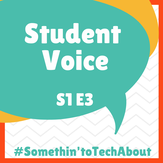 Every student has a voice and now with the help of technology, all students have the chance to be heard. By providing opportunities for students to have a voice in how they will learn and how they will show what they have learned, students' voices will be amplified and their learning will take on a whole new meaning. In episode 3, we discuss three tools educators and students can integrate into learning to amplify student voice, Flipgrid, Screencastify, and Anchor. 🎦 Flipgrid Flipgrid is a social learning tool that allows teachers to create "grids" to facilitate video discussions. Each grid is like a message board where teachers can pose questions, called "topics," and their students can post video responses that appear in a tiled grid display.
Once you and your students feel comfortable with some of the basic features of Flipgrid, why not visit the Flipgrid educator resource page for additional innovative ideas and if you are on Facebook, we recommend liking and following Flipgrid. They also have a very active Flipgrid Educator Group that is worth joining to see and hear how other educators are giving students a voice with the use of Flipgrid. 🔑 Resources: Flipgrid - Social Learning Flipgrid Educator Resources 💻 Screencastify Screencastify is a tool that allows students and educators to personalize their learning experience by sharing their voice via a screen recording. The app is a Chrome extension, meaning this versatile tool is just a click away on any device with a camera and microphone when you want to capture digital evidence of active learning!
🔑 Resources: Screencastify site Video Tutorials from Screencastify Screencastify Activity Ideas 🎤 Anchor There are many recording tools students and teachers can use to create podcasts. The tool we selected to share with you delivers a multitude of FREE options for users. Anchor is a free podcast web tool and IOS/Android app which walks users (age 13 and over) through the steps of recording and publishing a podcast. Anchor works on any device with a microphone, camera, and access to the Internet so it will take no time at all to get your students producing their very own podcasts! A classroom podcast fits all 21st-century skills into one project. Students collaborate and think critically to:
Advanced users can tech it up a bit for competitions by editing clips in Audacity and Garage Band where it is possible to add a music track behind the audio(currently not available in the web version of Anchor), remove awkward pauses, sneezes, laughter or other audio goofs without re-recording the segment. 🔑 Resources: How to Start a Podcast - with Anchor 18 Best Podcasts for Elementary, Middle, and High Podcasting for Educators with Deborah Hargroves Classroom application sample from Susie King Taylor Community School: How do you amplify student voice in your classroom? Share your experiences in the comments below and give us Somethin' to Tech About!
2 Comments
Libby Miller
5/10/2019 08:57:16 am
I absolutely love the Classroom application sample. Showing real examples of classrooms using technology is fabulous. These students were able to back up their choices for President with facts. The teacher had good probing questions and the students were obviously comfortable with the format.
Reply
Dana Gibbs
5/10/2019 11:41:37 am
Thank you for sharing. As I listened I got so many ideas as to how teachers could use these tools in the classroom. I especially like the idea of Screencastify in the math classroom. Students could record themselves as they complete activities with online manipulatives. Students can then share their recording with their teacher.
Reply
Leave a Reply. |
Categories
All
Archives
December 2020
|
 RSS Feed
RSS Feed